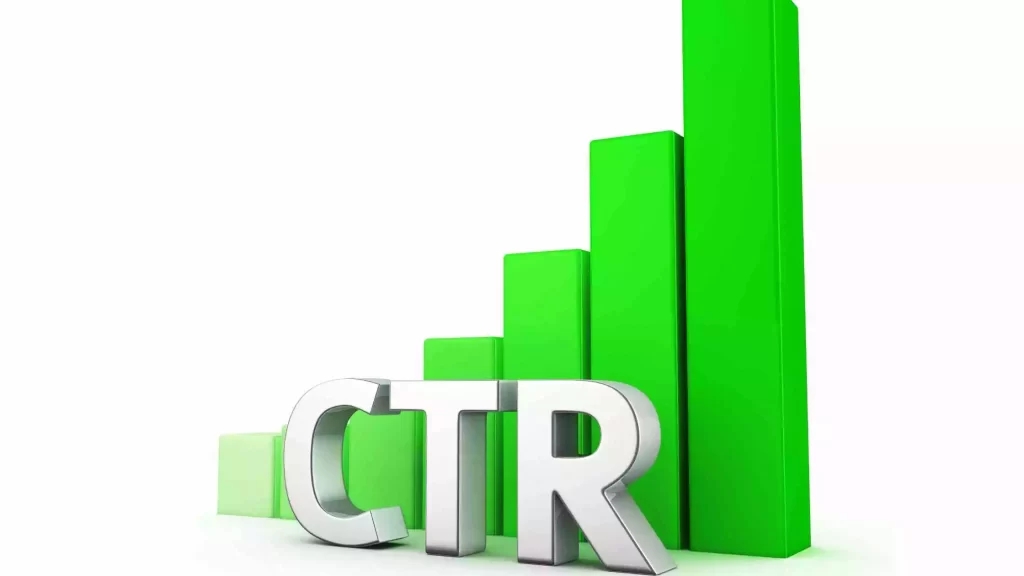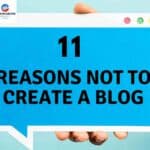Are you curious to know more about CTR? Would you also like to find out how you can improve your CTR by focusing on your metadata?
So read along here, where we focus on CTR and give you a range of advice on how to check your metadata for the seams.
What is CTR?
CTR is an abbreviation of Click Through Rate. In short, it is a number that describes how many people click on your page compared to how many users are introduced to your page.
Let’s say there are 200 Google users who come across your page through their searches. This means that there are potentially 200 users who could click on your website. Of these, eight clicks on your site rather than one of the other sites are shown.
In this example, you have a CTR of four percent.
It, therefore, applies that CTR = number of clicks/number of impressions.
That’s why you have to deal with CTR.
There are several different reasons why you should pay attention to your CTR.
We will get into that a bit more later. First of all, however, CTR is important to keep in mind because it is a really easy place to put in compared to trying to get more customers in the store.
Once you’ve cracked the code for creating great metadata, it doesn’t take much to improve your CTR.
Being the lucky ace that you are, we’ve even cracked the code for you, so you can sit back, read this blog post, optimize your metadata, and watch the millions roll into the bank account.
Okay, maybe I won’t promise you millions after all, but let’s do a little math just once and for all to establish the importance of CTR with the seven-inch nail.
Imagine that you have a webshop that sells pots. You are at the top of Google for the search term “pots,” which approximately 2,000 people search for monthly.
You currently have a CTR of 20 percent, which means that you get 400 visitors through the keyword every month. In addition, you have a two percent conversion rate, meaning that two percent of all those who visit your webshop end up becoming paying customers.
To take stock, you have 400 monthly visitors on the keyword “pots,” and you have a two percent conversion rate. That is, you have eight paying customers on this keyword.
If you increase your CTR by just five percentage points so that it lands on a total of 25 percent, you will suddenly get 500 visitors per month on the keyword. Assuming the conversion rate is unchanged, you now get 12.5 paying customers instead of the eight you got. With an average order size of 500 dollars (that seems reasonable when it comes to pots), you get an extra 2,250 dollars into the shop every month just by spending 10-15 minutes improving your title tags and meta descriptions. In one year, it will be 27,000 dollars. Not bad, right?
Consequently, there are many compelling reasons to request more for your metadata. Suppose you want more money in your bank account. We allow ourselves to assume that you would like to.
If this is not the case, we are sorry to have wasted your time, and you need no reason to read on. Then you can read our blog post on the ultimate guide on Lead Magnet. That way, you are sure that you won’t lose many potential customers.
Are CTR and ranking on Google related?
I promise we’ll get to the nitty gritty tips for optimizing your metadata to improve your CTR soon.
First, however, we need to take a closer look at how CTR relates to placement on Google. CTR and Google placement are intertwined in several different ways.
You will usually get a higher CTR if you are well-positioned in Google results.
Your page will naturally be shown to more users, and you will almost always get more clicks if you are in the top 3 than on page seven.
The higher position, therefore, provides the basis for a better CTR, but to have a good CTR, it also requires more clicks than it would if you were on page seven and were only shown three times a day. So it’s a bit complex.
However, when dealing with your metadata, you must try to take your position on Google out of the equation for a while. Your CTR says something about the number of clicks in relation to the number of views precisely, and your position on Google is essentially irrelevant in improving your CTR.
If you want to collect data on how your sharp metadata has improved your CTR, your Google ranking must be the same before and after you have optimized your metadata.
When I write that you have to take your position on Google out of the equation, that is not entirely true either. Or… It’s not possible.
There are many indications that your CTR is connected to your position on Google, just like your search engine optimization.
However, this is a whole universe, which I will not go into depth about in this blog post. If you want to know more about that, you can read this study on backlinko.com, which is about the connection between expected CTR, actual CTR, and position in the search results.
Capture users’ attention with your metadata
Now I guess I can’t drag it anymore. We will start with some good advice to help you optimize your metadata. Let’s do it!
It is clear that you want to be able to write nice title tags and meta descriptions that draw people to your page. If your metadata makes you fall asleep, no one wants to visit your website and have even more boring content thrown at them. Sorry to say.
However, the fact that your metadata must be catchy and act as an eye-catcher does not mean that you must throw yourself into something clickbait-like, where you come up with completely crazy metadata, which in reality has little to do with your page.
It applies to metadata in every other aspect of life: Don’t promise something you can’t keep.
If you lure many users to your website using clickbait-like metadata, you may risk shooting yourself in terms of SEO.
When you, as a user, come to your page and do not find what your metadata has promised you, you click away from the page again. This will make your bounce rate high and your dwell time low, and you certainly have no interest in that.
You must therefore write metadata that is catchy and relevant in relation to what can be found on your page.
Metadata can be compared somewhat to the back of a book. The back of a book should ideally make you want to read the whole book, but it should also give a realistic insight into what the book is actually about.
If the back of the book centers around aliens, you as a reader will be disappointed if the book is about prairie Indians and their philosophy of life. It is the same with metadata, if you catch my drift.
You must therefore ensure that you provide a nice and, at the same time, a real insight into your website’s content with your metadata.
In addition, you can incorporate many different things into your metadata to create eye-catching features.
This applies, for example, to characters such as |, », ✓ and ➤. They help make your title tags, and meta descriptions stand out, and in addition, they can make the metadata more manageable to look at.
A study by Hubspot also shows that title tags with one or the other form of parentheses generally get 33 percent more clicks than title tags without parentheses. That is a noticeable difference.
Numbers also generally work very well in both title tags and meta descriptions.
They quickly attract the user’s eye, which is why it is worth considering incorporating relevant numbers into your metadata. This, of course, applies to both numbers, brackets, and special characters. You must do everything in moderation and only if it is relevant.
Don’t permeate your metadata with all kinds of funny characters, emojis, and made-up numbers so that you can barely tell if it’s a website or if everything is written in complete slang. Use it wisely.
Speak to the user’s feelings
You want more people to visit your particular page because, hopefully, some of them can be converted into paying customers.
You can make sure that more people spot your metadata by using the different types of eye-catchers that we have covered a little.
However, it is not enough that a number or a bracket makes the user’s hungry eyes fall on your metadata. You must also keep the user’s attention and make them want to see more on your website.
To make sure that the user clicks on your page, it is wise to speak to the person’s feelings. We’re not asking you to come up with a heartbreaking story about your childhood or to write a raucous declaration of love straight out of a Romeo and Juliet novel.
No, it’s a bit more about the words you choose to use. These should be emotional and grand, so don’t be afraid to unleash your inner word juggler when writing metadata. If you use fluff and generic words, you hardly stand out from the crowd.
You can, therefore, safely use words like “excellent,” “eminent,” and “brilliant” if you want to lure users to your website. It is not too much, but enough to arouse the user’s interest. Instead of writing “Large selection of pans” – to stay with the pan webshop – you could therefore write “Excellent selection of pans.” It’s not a huge difference, but it could potentially make a difference in the number of paying customers.
Put yourself in the user’s shoes.
Unfortunately, all my (if I do say so myself) good advice about metadata cannot stand alone. You can easily throw around lots of big words and cute characters if you don’t manage to put yourself in the users’ shoes, Without an understanding of the search intent.
Good advice is, therefore, expensive in terms of improving CTR. (Even if you get them quite free right here).
It would be best to consider what the user is looking for when they type x number of letters into their computer or smartphone and anxiously wait for the search results.
When you can put yourself in the user’s place, you can meet the search intent already in your metadata, and that’s when you can draw some potential customers into the fold.
You must, so to speak, try to familiarize yourself with what need or problem the applicant has. Then you must (more or less indirectly) point out this problem and, in the same breath, solve it for the seeker as if you were sent from heaven like a little, helpful guardian angel.
Let’s assume the user is looking for new pots. Bids for meta descriptions could then be:
Are you missing new, delicious pots? Then visit Financebode.com, where we have an excellent selection of high-quality pots.
If you need new pots for the kitchen, you can visit financebode.com. Here you will find everything within pots.
Would you like to get your hands on quality pots at good prices? So visit financebode.com already today. There is always free shipping.
In these three examples, the user’s problem (the person needs a new pot) is addressed and solved (the person can buy them at financebode.com).
In this way, the searchers are guided onto the website, and you (hopefully) get more money in the till. If you always have the search intent in your mind, there are good chances of creating some relevant and delicious metadata.
You can address the need in several ways, but the attentive reader will probably have noticed that I have used rhetorical questions in two of the three cases above.
This is because they wanted to make the user think something a la,” yes, I need new, delicious pots, thank you very much!” after which the person jumps headlong into your page.
As you can see from the middle example, it can also be done more indirectly than with a question.
The most important thing is to show the potential customer that you have understood what they are looking for and that you can help meet the need or solve the problem.
How to write good title tags
When writing title tags, you have approximately 45-55 characters to work with. It applies to title tags and meta descriptions that it is calculated in pixels. And when I write characters, it is therefore purely for convenience.
You can use this tool to your advantage when you need to write metadata. If you want to be sure you don’t write too much. Go for mobile preview, so it fits a smartphone screen too.
45-55 characters are not very much. And writing good title tags can be easier said than done.
There is also a big difference in what works from website to website. Therefore, it is impossible to come up with a definitive conclusion.
However, a good starting point is to use the structure below. Then you can always adjust according to what works and makes sense for your site.
As a rule, webshops often use CTAs, while other websites typically use USPs. What makes sense for you depends on the nature of your website and what your goals are.
For example, if you have a consulting business. It is not so relevant to advertise with a large selection or fast delivery. On the other hand, it is relevant if you have a webshop.
Since you only have very few signs of doing well. It is essential that you carefully consider what is most important for you to be mentioned.
For example, you typically choose to mention the company or the brand name. But you should only do so if it has some weight.
Otherwise, the characters can be used better.
If, on the other hand, we were talking about a tiny company (for example, our imaginary financebode.com from before). Which no one has heard of before, it is outrageous to use 15 characters to name it.
In short. You need to weigh each character and ensure that all 45-55 characters create value in one way or another. When writing title tags, keep this in mind above everything else.
What works in meta descriptions?
Let’s skip ahead to meta descriptions, the slightly longer text pieces you see under the famous title tags.
Here you should write a minimum of 125 characters and a maximum of 155, but again. It is actually about pixels, so the 125-155 characters are just a guideline.
If a Google user reads your meta description, you have already managed to catch their attention with your title tag.
You now want to retain and stimulate this Google user further with the help of your meta description. This is an ultra-short introduction to your website.
If your meta description is irrelevant to the user, boring or sloppy. There is a vanishingly huge probability that they will choose to visit your page. Therefore, you must also make something out of your meta descriptions.
Since you have more characters to use here than you do with your title tags, you also have a little more “artistic freedom.” But a fairly safe structure is: Primary keyword – Addressing needs/ content on the page – CTA/ USP.
We have already touched on this addressing of needs previously, which becomes really important when it comes to meta descriptions.
Whether you sell pots, work as a consultant, design websites, or have a veterinary practice. You can start from the same basic model when creating metadata.
Everyone who searches on Google has either a problem or a need, and if you are smart enough to see this through. You may be lucky enough to get many searchers onto your site instead of your competitor.
How to get a higher organic CTR
A lot affects your CTR. Unfortunately, I can’t promise you that you can get more paying customers just by optimizing your metadata.
On the other hand, I dare to promise you that it is worth the try. It does not take long to run through one’s metadata, and concerning how big a difference it can make. I would dare to say that it is worthwhile trying.
Here is a summary of my advice on how to write metadata, so you can easily get started yourself:
- Your meta descriptions should be approximately 125-155 characters.
- Your title tags should be around 45-55 characters.
- It would be best if you used CTAs and USPs that make sense for your website and your goal.
- You need to make your metadata inviting and clear using characters such as parentheses.
- You must capture the user’s attention with, for example, numbers.
- You must put yourself in the user’s place and try to understand the search intent. Find out the user’s needs and uncover this.
- Don’t promise something in your metadata that your page doesn’t deliver. This results in a high bounce rate, which is not desirable.
- Weigh every tiny character in your metadata. With a maximum of 210 characters to route with, there is no room for unnecessary padding.
Unfortunately, it is not possible to come up with a completely bulletproof metadata recipe that you can follow slavishly in the pursuit of a better CTR.
However, if you follow the above guidelines and take what you have learned in this blog post with you, there is a certain probability that you can get more visitors and, thus, more customers with the help of your metadata.
At least it’s worth a try, I think.
Otherwise, you can skip Amino and read my post, “The battle for the click,” if you need more inspiration.





